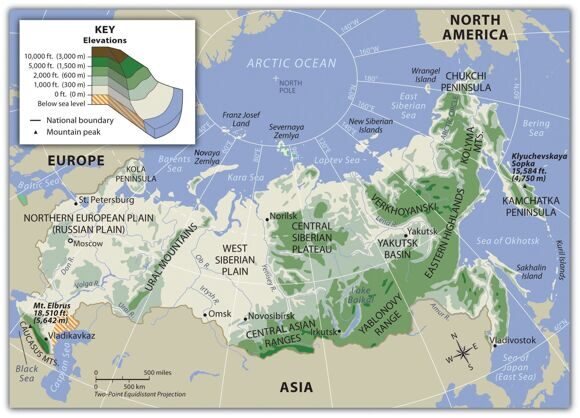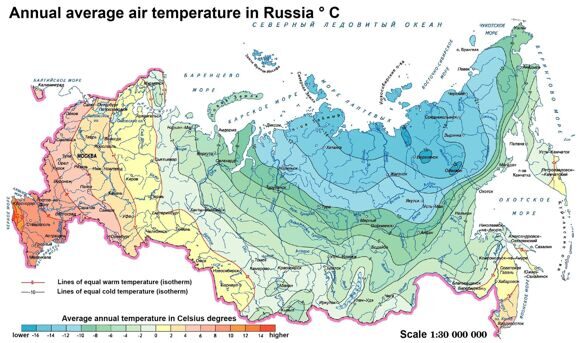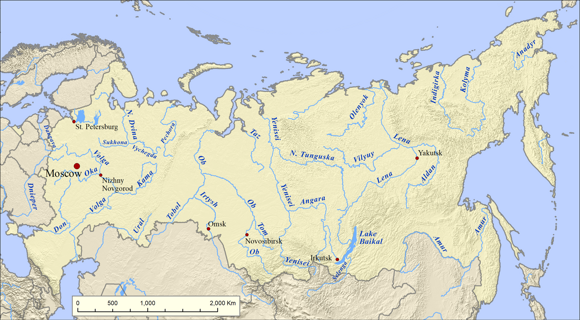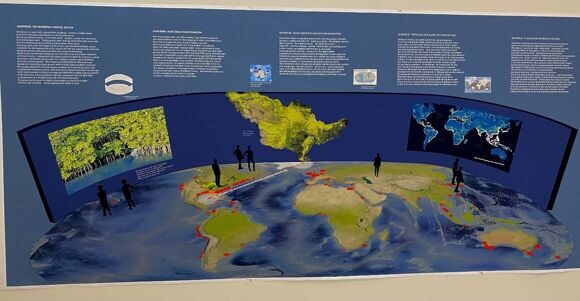SENSORIUM: THE THINKING

Newton Harrrison,
Research Professor and Director of the Center for the Study of the Force Majeure, the University of California at Santa Cruz, Director of Harrisons Studio, and Professor Emeritus, the University of California at San Diego (CA, USA).
Abstract
One of the pioneers and leaders of the eco-art movement, Newton Harrison, presents the Sensorium, a work of art and of science that sets out to provide a whole systems visualization of the problems that the world ocean faces, as well as potential solutions to these problems. The Sensorium is an immersive environment, a fully interactive 3-dimensional human-centered interface, where the floors, walls and even the ceiling act as “live” surfaces, connected to real time data, information and modeling / simulation tools. It has a series of functions including education and holistic decision making, as it allows people to interact directly with the ocean through the interface. Most significantly, Sensorium can operate as a generalized pre-emptive planning environment where oceanographic problems, mostly of human creation, can be seen and acted upon because their interconnectivity is understood at one glance and all together.
Key words: world ocean, life web, immersive environment, counterforce
Sensorium is both a work of art and of science that sets out to synthesize the survival problems that the world ocean faces in our emerging heat shocked future. The work is designed by myself, Newton Harrison, and emerges from the Center for the Study of the Force Majeure, located at the University of California, Santa Cruz. Personally, I am grounded in the arts, the sciences, and have been working for the past fifty years on systemic environmental problems such as topsoil degeneration, planetary warming, atmospheric imbalance, forest and oceanic degeneration. Sensorium is our most recent effort in addressing the ongoing degeneration of our world ocean’s life web. Attached to this written proposal/explanation is our book entitled The Time of the Force Majeure: After 45 Years Counterforce is on the Horizon, written by myself and my life partner Helen Mayer Harrison, now deceased. By way of history, our work is acknowledged as foundational to the rapidly growing eco-art movement, with our first global warming work done in 1974. Sensorium is an example of what we mean by counterforce. Through Sensorium, I am proposing a form of expression that references the whole systems knowing that our ancestors practiced as part of their everyday survival mechanisms, which has now faded to a whisper in modern western life.
I begin this commentary not in the present but imagining myself as living a tribal life, one hundred thousand years ago, standing in the high grasses not far from the open canopy forest from which I emerge. The grasses are tall, but I can see above them. A hundred yards away the tall grasses wave in a manner that signals a large animal is present (a classic example of figure ground perception). A tail is then seen and instantly the image of a tiger comes to mind - as one of my human visual talents is to create a whole from seeing or hearing only a part. If the wind is blowing away from me, then I need not flee. If the wind is blowing from me towards the tiger, then flight takes over as the tiger would smell me. At the same time, my personal sensorium is picking up sound, wind, subtle changes taking place in many different forms, while registering places to escape and hide, all at once and all together. I am having a whole-systems fight or flight response to a clear and present danger. The survival principle at work is scanning, which led to this nearly instantaneous, un-rationalized and holistic response. I believe that the potential for this kind of perception and survival response from the human sensorium has been so reduced by modern life that large system scanning and improvisational response has ceased being an environmental survival strategy in contributing to safety in everyday life.
Instead, this talent has devolved (with some notable exceptions) to what can be derived from the computer screen experience. I believe that this human loss is catastrophic for the life web of the planet. This is because decision-making, still mainly Cartesian in nature, is now made part by part, in a fragmented, environmentally disassociated manner, which requires the world to be viewed as a mechanism rather than a living, changing system. This is typical for much present-day research and most modern people, who no longer see and act on what is happening all over and all at once, like our ancestors once did. Even though the ancients’ historic perception was local and ours in this very complex modern world must become global, I believe our original capacity for whole systems scanning and response is vital to our continued survival.
In the brain, cognitive science reveals that neurons devoted to visual processing number in the hundreds of millions and take up almost fifty percent of cortex, as compared with eight percent for touch and just three percent for hearing. This indicates that retrieving and evolving our original scanning skills is necessary if we are to successfully respond to the problems operating in all systems all at once due in good part to planetary heat shock.
In response, we at the Force Majeure Center propose an intervention that is a digital expression of how we, in modern world terms, can go about reestablishing whole systems seeing, decision-making and above all action. The intention is to bring whole systems scanning back as a part of everyday experience, and to use this once common and natural practice both in scientific research and everyday life.
Figure 1 The Sensorium general lay out. Please, see the 5 texts on top of the images presented at the footnotes

Figure 2 The Sensorium complete is in the round
To this end, we are in the process of designing a new kind of instrument that takes up the middle ground between the telescope, which sees far and the microscope, which sees near. The instrument we have in mind sees in the now and is supported by scientific research which demonstrates the large proportion of our brains that is committed to processing visual information. We tentatively call this new instrument “Sensorium.”
We note that a great deal of restorative oceanic work takes place in a one at a time, problem-solving, reflexive manner. Whether we are looking at the loss of coral reefs, dead spots, heat pollution, fish farming pollution, acidification, rising oceans or plastics removal (obviously, the total list of problems is much longer).
In contrast, the immersive work we propose, by combining art and science, opens up space of mind for a new, useful-for-all kind of oceanic narrative to emerge. We start with the concept of creating a fully interactive 3-dimensional human centered interface, where the floors, walls and even the ceiling all act as “live” surfaces, connected to real time data, information and modeling / simulation tools. Building on and incorporating elements of 2D, 3D, VR and sophisticated audio tools, the goal is to build an experience for the user that bring visual, audio and haptic experiences together in real time. In this article we won't describe the technology in depth but focus on the experience of the user. The experience begins with an interactive, programmable floor which is on a raised platform. Sensorium requires a large space, an area of at least 1500-2000-square-feet. On the floor is a potentially ever-evolving world map with all the world's oceans delineated. Emerging from this digitally expressive surface, the walker will encounter the ever-changing locations of the principle ocean stressors. For instance, if one is walking the ocean close to Chile, one of the principle stressors would be fish farming, particularly shrimp, the pollution from which has a negative impact on normal oceanic ecosystems. In this case, a local solution would be taking the polluted waters and pumping them on land to a swamp-type wetland. This action would purify the polluted water sufficiently so that when it returned to the ocean it would be oxygenated and function as nourishment, rather than generating hypoxic conditions.

Figure 3 Mississippi river basin

Figure 4 Sensorium reveals a transoceanic pattern for wetland restoration where every ship on the whole ocean is marked
In addition to presenting solutions to such local problems, part of Sensorium’s purpose would be to dramatically express the need for global ocean governance that could enforce a whole system rule of law. This global system of governance would need to have the power to penalize polluters on a global scale and demand drastic changes such as the invention of biodegradable plastics. Sensorium would also holistically demonstrate the profound benefits that would arise from a regenerated ocean and, in the long-term, exceed the costs required to bring about such changes. Moreover, visualizations that come out of Sensorium would illustrate what might be done about ecological problems facing the world's oceans, what it might cost, and also what would be the cost of not taking action.

Figure 5 Mapping plastics pollution
In response to a certain question, a tsunami might be projected onto the walls for a minute or two, followed by another environmental catastrophe and then another. Such emotive imagery might be projected repeatedly on different walls at different times – but only as requested and within the context of a large, oval, cathedral-like space. Questions asked of Sensorium are responded to visually, auditorily and with printed text. Sensorium is designed to present information comparatively. For instance, those who engage Sensorium might choose to examine the overall death risk facing the world ocean. Sensorium might suggest six factors which are destroying ocean life simultaneously:
• Increase in atmospheric carbon
• Increase in oceanic acidity
• Decrease in the ocean’s ability to sequester carbon, its capacity reduced mainly by increased acidity
• Decrease in production of oxygen both in the atmosphere and oceanic waters
• Perturbations from extractions in virtually all life support systems
• Dramatic cross oceanic ecosystem disruption through pollution, particularly plastics.
What I am describing here is a first sketch for perhaps one of the most complex immersive systems ever put in place. It has multiple functions – firstly, it educates and allows people to engage personally with the ocean. More significantly, Sensorium can function as a generalized pre-emptive planning environment, where oceanographic problems, mostly of human creation, can be seen and acted upon because their interconnectivity is understood all at once and all together. Of particular interest is how oceanic stressors interact with one another, and where solutions can be sought out that are not models or bits and pieces of larger problems, but real-world, large systems solutions.
Furthermore, Sensorium can give details of the local place of each oceanic problem, with poetry in the language of the visual arts in tandem or interacting with the language of science, always with the life web as the instructional source. Sensorium may use poetic language, including metaphors, such as only a fool picks a fight with the ocean or every place is the story of its own becoming, to communicate more deeply and holistically.
Accompanying this narrative is a 42” by 98” sketch presenting how Sensorium works visually (Figure 1). This image makes clear why we believe Sensorium is of great potential importance. For instance, the sketch image demonstrates a potential resolution for dead zones, which involves the recreation of land-based wetland purification systems. What becomes visible, through Sensorium's unique way of presenting such ecological problems, is the multifaceted ecological value such wetlands have world-wide, as they also function as sanctuaries for birds and other, often endangered species. Sensorium is then asked, perhaps by a different group, a question such as: how can diverse types of pollution generated as waste from ocean vessels be managed? The answer, stimulated by the newly visualized wetland pattern, is to mandate wastewater from all shipping to be introduced to these newly created wetlands. The new wetlands work thus integrates the process of purifying highly polluted water from ships, which can then return to the ocean.
Sensorium is actually a form designed in consultation with the life web. Properly used, the oceanic sensorium can become the voice of the world ocean. Sensorium works to make visible what is happening in transoceanic waters at any place and any time, always assuming programming is up to date. Finally, in the attached Sensorium sketches we reflect on the oceanic voice speaking truth about its nurseries, its sanctuaries, its dead zones and the endless infusion of plastics from large to tiny. Acting on these four voices all at once, from our position as artists, generates deep empathy for the ocean, literally the mother of life itself, which is endangered by our own actions. The cathedral-like structure and presentation of the images and information add emotive power to Sensorium’s expressive and preemptive planning capacities.
The intention of Sensorium is for the scientific, governmental, cultural and industrial communities to be able to visualize the ocean as a whole and to do so in each other’s presence. Sensorium encourages holistic decision making about how to connect disparate parts of the bigger picture and ensure total oceanic well-being. Sensorium is a whole systems visualization digital structure that automatically generates transdisciplinary outcomes. It tunes itself to whole systems seeing, thinking and being, in this case with the world ocean as beneficiary. Finally see addendum* where the value of Sensorium can be projected onto the Plains of Russia, even as far as the North Pole.
Footnotes
Text 1
SENSORIUM: THE BEGINNING. A PARTIAL SKETCH
Sensorium is a space cathedral like sensibility created to enable anyone
To generate and experience discourse with the world ocean
Sensorium presents visually in scientific detail complex oceanic life web threats
By revealing dead zones endless plastic input with the distributed waste from ships
From fish farming and ocean netting creating bottom dead spaces
Sensorium can give voice and image to both oceanic and land-based pollution sources
Responsible for the degeneration of the oceanic life web now experiencing extinctions
Sensorium permits multisystem scanning and seeing simultaneously
Similar to the envisioning developed by our ancestors to survive in their ecosystems
And become niches setting tribal life support patterns in place for long term survival
Sensorium is speculative design work that manifests complex oceanic problems
All at once and all together often requiring transdisciplinary efforts by many
Sensorium’s visualizing system permits direct work on multisystem problem resolution
For instance, sensorium envisions oceanic nurseries as a network that can call forth
A transoceanic sanctuary pattern then envisioning revitalized dead zones transformed
While simultaneously revealing an unexpected resolution to global shipping pollution
Simultaneously visualizing plastics and its elimination from the food chain
As fundamental to a healthy oceanic life web as imperative
Sensorium has the power to express relationships not previously
Seeable therefore knowable thereby opening new space of mind
Text 2
SENSORIUM: DEAD ZONES TRANSFORMATION
Well-mapped dead zones over 450 in number have formed at coastlines
With oxygen depletion from the overproduction of algae as the death cause
Sensorium first maps the worst of places making clear that
Most oceanic dead areas happen as a result of land-based pollution
Often river inflow from agro-industrial waste urban and industrial waste
Worst is the outfall from the 1.2-million-square-mile Mississippi drain basin
Pouring into the Gulf generating a 1000-mile-long 7000-square-mile dead zone
Soon to be 8000-square-miles from the Mississippi outfall to the Galveston Bay Sensorium’s visualizations make clear the need for land-based purification systems To be created on the coastline between the Mississippi outfall and Galveston Bay
Short-term solutions happen when saltwater wetland swamps are created
With pumping systems invented to exchange newly clean waters from the
Wetlands and polluted Gulf waters from the dead zone newly reoxygenated
First become productive living zone or even a candidate for sanctuary
Long-term solutions require all pollution sources agro-farming in particular
Need resolution at their source of creation
Complex in solving but imperative in the doing
Text 3
SENSORIUM: OCEAN NURSERIES AND PATTERN RECOGNITION
Sensorium’s pattern visualization process makes clear that oceanic nurseries
These diverse mothers of oceanic life are mostly local places all calling for sanctuary
When nurseries the mangrove forests the mouths of estuaries
Coral reefs estuarine wetlands swamps nursery slicks and upwelling areas
In their entirety are conjoined and developed as sanctuaries
Sensorium can then visualize a transoceanic life support system
With protected nurseries acting to protect the beginnings of most oceanic life
Collectively protecting nurseries makes for a valuable new pattern discovery
Sensorium envisions conjoining a nursery sanctuary pattern with revitalized dead zones
Revealing a complex eco-regenerative transoceanic sanctuary pattern
This envisioning further indicates that an oceanic sanctuary pattern this complex
Wherein dead zones the worst of places and nurseries the most endangered of places
Conjoins in an ongoing foundational source for oceanic life webs continuing evolution
And with the beginning of life protected and oceanic well-being guaranteed
The invisible beneficiary is land-based life including our own ability to continue
Text 4
SENSORIUM: EXPRESSES A GLOBAL WETLAND PATTERN
Sensorium reveals a transoceanic pattern for wetland restoration
If saltwater and brackish water wetland purification systems are created
Whose work is to receive and transform deoxygenated eutrophic waters
From the 450 land-adjacent dead zones then exchanging them with healthy
Nutritious reoxygenated waters with dead zone waters can be transformed
Into the healthy biotope that existed before extreme extraction and pollution
Sensorium seeing a new global pattern of wetlands reveals alternative outcomes
Responding with a mapping of daily oceanic vessel presence in a shocking snapshot
Making clear a necessity that ships transfer waste to wetlands nearest port of arrival
Thus, relieving the ocean from yet another intractable pollution assault
All costs borne by polluters the beneficiary the world ocean’s life web
With recovering fish populations and extinction reduction as outcomes
Sensorium continuing in transaction with multidisciplinary human explorers
Can make clear that only the overproduction of fish populations can be the harvested
Envisioning the harvesting redundancy as preserving the system
Protects oceanic systems biota population balance to stay intact
And become the life web’s way of continuing while serving human need
Then criminality is associated with overharvesting and pollution creation
And human behaviors that cause oceanic life web degeneration
Text 5
SENSORIUM: PLASTICS AND THE OCEAN’S LIFE WEB
Sensorium in the beginning of its development responds to the question
What is the most dangerous single element infecting the life web?
Its response now held by many is that plastic particularly micro bits
Negatively affects life that ingests it first in the oceanic food chain
Then infecting land-based life particularly the human food chain
So, sensorium visualizes this vast plastic infection from land-based manufacture
Infecting rivers oceans oceanic life and all who consume oceanic life
Sensorium sees the Benioff Clean Ocean Currents Coalition
As the most comprehensive viable approach to whole-systems plastic removal
Sensorium presents the coalition mapping oceanwide as force full evidence
Coalition then choose 9 of 1000 rivers to install massive plastic recovery systems
Their discovery is that 80 percent of plastic pollution
Into oceans world-wide is transported by these 9 rivers
Plastic river capture removes plastic waste before ocean entry a short-term solution
This coalition simultaneously engages in eco politically land based long-term solutions
Calling for recyclable alternatives dealing with plastic pollution on site
The beneficiaries are all oceanic and land-based life particularly the human food chain
Sensorium visualizes the value of the reduction of plastic production possible
Only when agreement is developed to leave coal gas and oil in the ground
Sensorium’s search found no better whole-systems thinking and work safeguarding
Virtually all oceanic life in the doing then this coalition’s work
*Sensorium addendum
The Vastlands
We think the Sensorium concept is repeatable at scales large and small. The differences being in the main the energies available, the lands available, the waters available, including the lives, ourselves and our companionate species. For instance, a vast new northern landscape becomes visible as haven for the life web especially when looking northward from Moscow past the Urals into the Siberian Plateau even the East Highlands. For instance, the 4 million square kilometer Russian Plain co-joined with the vast Siberian sub plains form a unique body of land, serving a unique grouping of species, endangered and not, within what I call the Vastlands. The creation of a Sensorium for the whole of these lands although smaller than the world ocean enables the workings of a complex new future that would enable the life web’s survival with human populations functioning as a niche within it. This would ensure the continuing of the human race which at present seems uncertain. We use the term continuing since we consider it important to emphasize the non-static continuous changing that is inherent in all life forms. The more common word sustainable does not convey the nature of the indeterminacy principle and we consider it misleading. This new envisioning of a Sensorium for this whole region would then produce a survival based eco-human collaboration. The outcome from this collaboration we envision is a bi-continental biodiversity continuum. This can be evolved where species from both Asia and Europe—driven northward by the heat—would be then able to niche into the heat-transformed biota of this vast terrain. At the same time, if syntropic farming topsoil regenerating, biodiversity technologies are introduced in the food-producing sector of this vast terrain then finally food production and biodiversity can be cojoined. If this course of action is developed, we would have a bi-continental drought compensatory system at work. Where food is no longer sufficiently produced in drought-ridden Europe and drought-ridden Asia it can be produced in a re-considered Russian Vastland. We see this effort as of equivalent value to the World Ocean Sensorium. We also see great benefit from creating a scattering of regenerative Helen’s Towns across both the Siberian steppes reaching back into the Russian Plain.
A Vastland Sensorium coupled with Helen’s Town settlements answers a multitude of questions that are scientific in nature and also human and fundamentally ecological as well. The total formation, the concept of human community becoming a self-made niche in a large environment of their own creation, is a profound life web acknowledgement even apology collectively ecopoetic in its visualizations as well as autopoietic in its structure.
Figure 6. Diversity of altitude acts in support of diversity of species, farming, and human cultures.

Figure 7. The temperature gradients for the whole region move from warm to very cold. This mapping suggests the complexity of change that must be adapted to across the whole region

Figure 8. 20 watersheds made visible by major rivers all shape the lives within them both similar and different one to the other each watershed adding its own biota and productivity to the whole
Reference for citations
Harrison, N. (2021). Sensorium – the thinking. Ecopoiesis: Eco-Human Theory and Practice, 2(1). [open access internet journal]. – URL: http://en.ecopoiesis.ru (d/m/y)
DOI: 10.24412/2713-184X-2021-1-57-64


